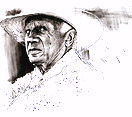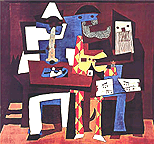 Born Pablo Blasco on October 25, 1881, in Malaga, Spain, to José Ruiz Blasco, and Maria Picasso-whose name he took after 1901. Picasso is largely considered one of the most influential artists of the twentieth century. He is best known as the inventor of the revolutionary art style, principallyCubism; and for his contributions as a sculptor, painter, and designer. Born Pablo Blasco on October 25, 1881, in Malaga, Spain, to José Ruiz Blasco, and Maria Picasso-whose name he took after 1901. Picasso is largely considered one of the most influential artists of the twentieth century. He is best known as the inventor of the revolutionary art style, principallyCubism; and for his contributions as a sculptor, painter, and designer.
In 1891, Picasso moved with his family to La Coru?a, where he studied fine art formally, as well as with his father, who was an artist and former professor at the School of Arts and Crafts in Malaga. The family moved again in 1896 to Barcelona, where Picasso excelled at the School of Fine Arts. In 1897, he entered the Royal Academy of San Fernando in Madrid, an academic environment he foundstifling. Picasso promptly quit the academy and returned to Barcelona, where he surrounded himself withvanguardartists and writers, continuing to study art informally.
Picasso traveled between Barcelona and Paris from 1900 to 1904, and afterward lived almost exclusively in Paris, where he was aprominentfigure among hiscontemporaries.
 |
| Three musicians |
One of the more remarkable qualities of Picasso's career was the rapidity and ease with which he evolved from one artistic style to thenext. His work between 1900 and 1906 was representative of theImpressionist stylefounded by masters such as Matisse, Claude Monet, and Georges Seurat.
The years between 1901 and 1904 are considered Picasso's Blue Period, so named for the dominant use of blue in his paintings. From this period, his most outstanding works were The Soup (1902), Crouching Woman, and Blind Man's Meal (1903).
Generally regarded as the first cubist painting, Les Desmoiselles d'Avignon was created in 1907 and represents what stands as Picasso'sseminalartistic achievement: the foundation of the Cubist movement.
From 1912 to 1915, Picasso and Braque began experimenting with new techniques that evolved naturally from the principles of Cubism. Using papier collé-a type of paper glued ontocanvaseswith various other materials-they created a new form known asCollage.
During World War I, Picasso befriended poet Jean Cocteau, with whom he collaborated on a production of the ballet Parade.
During the 1920s, Picasso contributed to the risingSurrealistmovement,spearheadedby artists like Salvador Dali and André Breton. Picasso's popularity did not cease after this point-in fact, it grew steadily throughout his relatively long life (he died at the age of 92 )-but his dominance as an artist began towane.
During the Spanish Civil War, which began in 1936, Picasso painted one of his most historically significant works. Guernica (1937) was Picasso's response to the bombing of a mostly civilian Spanish villa in the Basque region by Germans allies of Spanish dictator Francisco Franco.
 |
| Guernica (1937) |
World War II then broke out, and throughout the duration of the war, Picasso remained in France, despite the occupation of German armies. There he was allowed to continue his work without incident, although the Nazis forbade him to exhibit any of his creations.
After the war, Picasso experimented in mediums other than painting and sculpture, including writing.
|
(美术)立体派
沉闷的,令人窒息的
先锋
卓越的;重要的
同时代的人
印象派主义风格
有发展性的
油画布
美术拼贴
超现实主义者
...的先锋;为...扫清道路;带头
衰退,衰落
|
